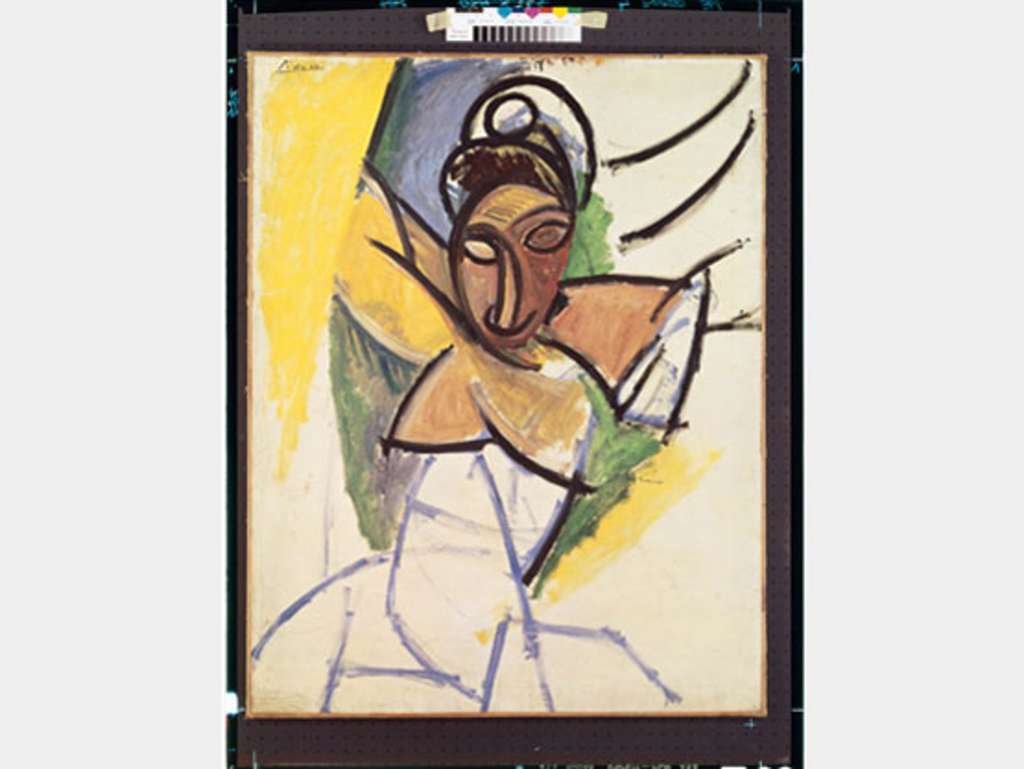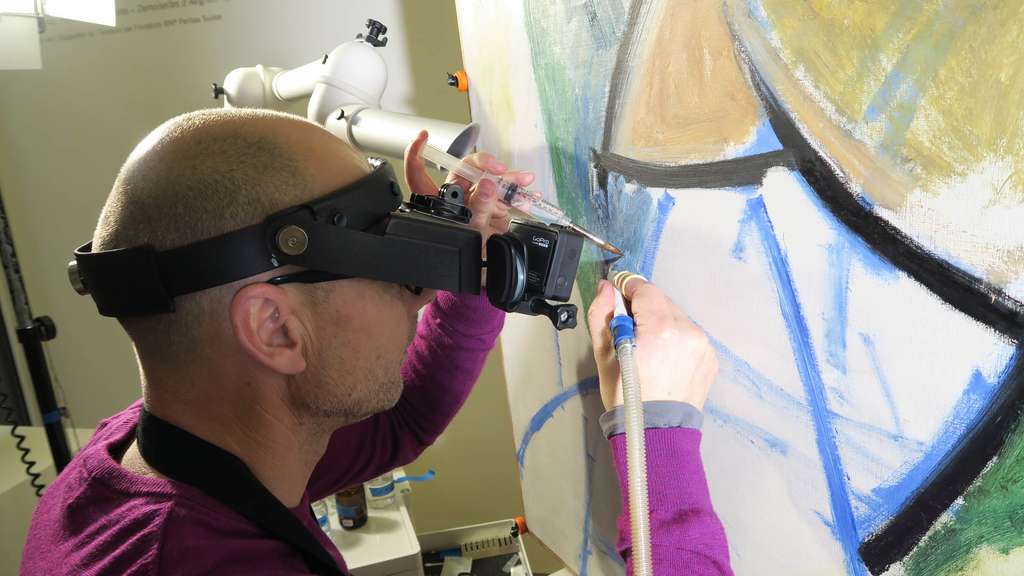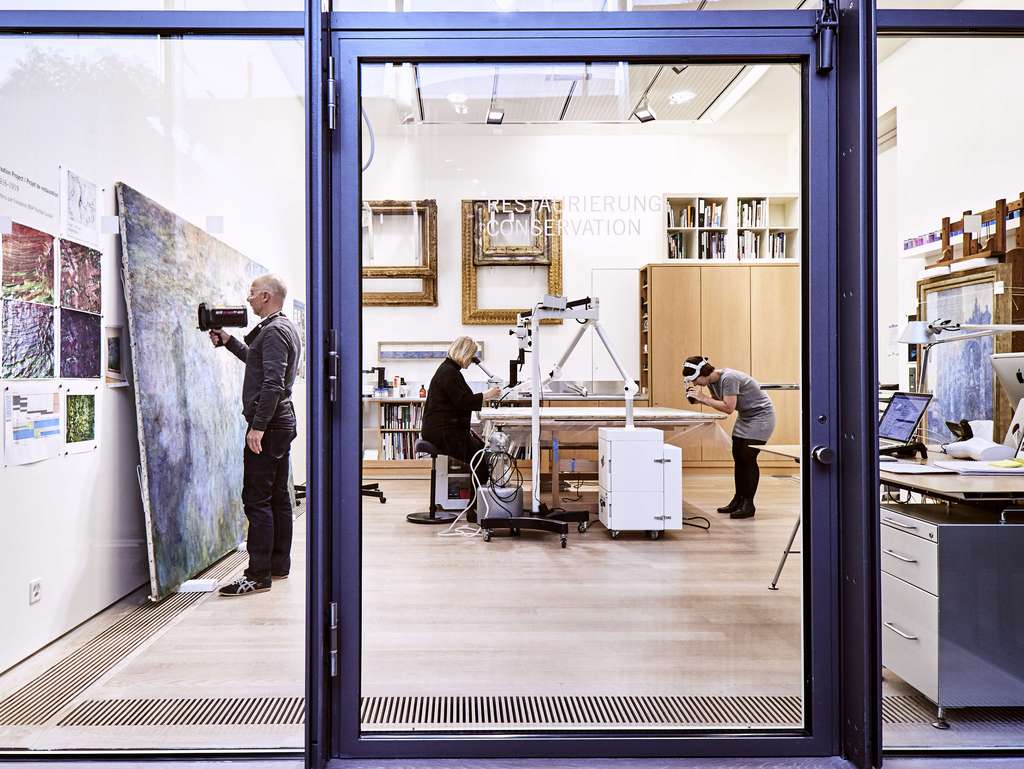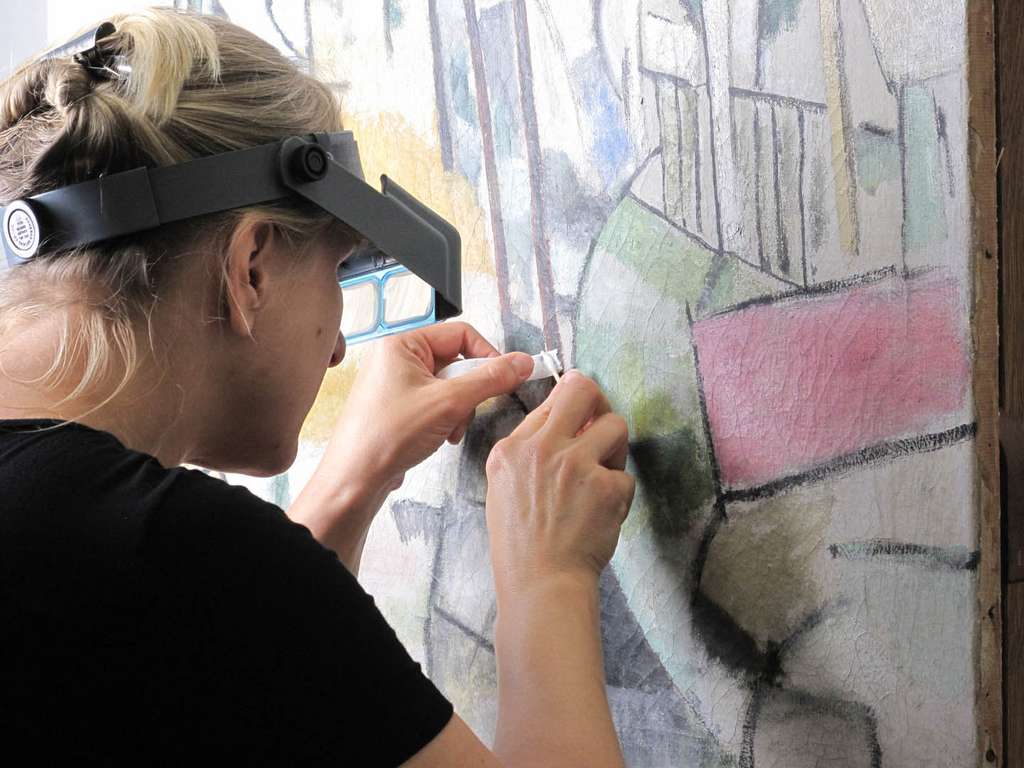PABLO PICASSO: SURPRISING DISCOVERIES
Pablo Picasso’s Femme (Époque des “Demoiselles d'Avignon”) from 1907 was the first major work in the Beyeler collection to be scientifically examined and treated outside of the museum. Fortunately, the renowned Getty Center in Los Angeles collaborated on the project. The research process brought to light many surprising discoveries about the Beyeler couple's most treasured painting.
ART-HISTORICAL CONTEXT
After his lyrical Rose Period, Picasso went in a radically new direction influenced by Paul Cézanne, Henri Rousseau, and African art that would go down in art history as Cubism. It reached its height in 1907 with the masterpiece Les Demoiselles d’Avignon, which hangs today in the Museum of Modern Art in New York.
The painting in the Beyeler Collection titled Femme shows a related motif: a standing female figure displaying itself with raised arms. The seemingly unfinished appearance is particularly obvious: the lines and surfaces of the figure connect only at the top in the center of the painting. With this, Picasso made the development of his painting visible.
![[Translate to Englisch:] Portrait Picasso [Translate to Englisch:] Portrait Picasso](/fileadmin/_processed_/d/c/csm_Pablo_Picasso_2_e9bb0d1d2d.jpg)
Pablo Picasso: Biography
The Spanish painter, graphic artist, and sculptor studied art in La Coruña, Barcelona, and Madrid. In 1900 he began making trips to Paris and finally settled there in 1904. In 1907, after the Blue and Rose Periods, he painted the Desmoiselles d’Avignon, the first major Cubist work. He began using collage techniques and making sculptures in 1912. From 1917 he designed costumes and stage sets for Sergei Diaghilev's Ballets Russes.
In the early 1920s, he switched to a neoclassical style. In 1925 he participated in the first Surrealist exhibition in Paris. He created his first large-scale sculpture using scrap metal and iron. He commemorated the 1937 bombing of the Basque city of Guernica by German aircraft for the Spanish Pavilion at the World's Fair in Paris that same year. The monumental painting Guernica uses symbolic means to depict the horror of war. In 1939 the Museum of Modern Art in New York held a major retrospective of his work. During the German occupation of France, he was not allowed to exhibit his work. In 1949 he moved to the south of France, where he had spent his summers painting since 1909. His late works are characterized by stylistic variety and dialogue with the Old Masters. Wildly painted nudes dominated the mid-1960s. The Museu Picasso opened in Barcelona in 1970 and the Musée Picasso in Paris in 1985.
Initial condition
During the conservation project, important questions concerning the painting’s history, work process, and pictorial technique were raised, especially in connection with the famous painting Les Demoiselles d’Avignon. Conservators wondered, for example, why Picasso had dabbed color samples at the top edge of the painting, making a sort of “palette.” An assessment of the painting's overall condition and alterations was also given considerable importance. Comparison with an old slide (figure 1) from the museum archives told conservators that the color had changed in some areas. The knowledge gathered formed the basis for the conservation measures to follow.

Helpful sources
Figure 1: This old Ektachrome color slide from the Beyeler archives is one of the most important resources for determining changes that have taken place in the yellow areas of the painting.
the artwork
As part of the partnership program for paintings conservators (Conservation Partnership Program), Markus Gross, chief conservator at the Fondation Beyeler, was able to examine the painting for three months in the studios at the Getty Center in Los Angeles. This was done in collaboration with Douglas MacLennan, assistant scientist at the Getty Museum and Getty Conservation Institute.
Technique and materials
All pigments used were examined with the help of X-ray fluorescence analysis (RFA). A standard palette of tube paints from this period in Picasso's career was identified: lead white, cobalt blue, cinnabar, Schweinfurt green, bone black, iron oxide and two cadmium pigments. Two additional colors were found only on the “palette” at the top edge of the painting. This lent weight to the hypothesis that these paint samples did not originate at the same time as the painting, but that Picasso put them there at a later date. A further argument for their later application was the absence of this "palette" in a photograph of the studio from 1908.
In order to draw inferences about the painting technique, near infrared multispectral imaging was used in conjunction with special software. This technique makes it possible to characterize and group the colors used in the painting. Because cobalt blue was the only blue pigment identified, it was possible, for example, to map this blue used by Picasso in areas where it had been mixed with other tube paints.
Analysis of paint samples
Comparison of the painting with an old color slide from the museum's archives clearly indicated that the areas of lemon yellow paint flanking the figure had faded.
Additional examinations (cross-sections, scanning electron microscopy [RMX-EDX], infrared spectroscopy [µFTIR]) on a selection of minute paint samples provided unexpected results: Picasso used a cadmium sulphide pigment that had already been identified on contemporary works by Matisse and Van Gogh. The process of deterioration, a physical decomposition of the 10-15 µm thin upper layer that resulted in browning, was primarily caused by a reaction to light and humidity. In spite of intensive efforts, however, the complex process of deterioration could not be fully explained.

Varnish removal
Figure 2: Markus Gross removing the layer of varnish on Femme (Époque des “Demoiselles d'Avignon”) in the conservation studio at Fondation Beyeler.
the artwork
Condition and conservation
Structurally the painting was in good condition. A layer of natural resin sprayed on at a later date formed irregular spots in the area of the figure and was considered aesthetically unsatisfactory. This layer had considerably altered the original, predominantly matte color balance, heightening the contrast and causing shifts in color. From literature and comparison with other works we know that Picasso did not use varnish during that period.
There were strong arguments in favor of a removal of the varnish, including the hope that the lemon yellow layer of paint would be less subject to deterioration, as varnish catalyzes the oxidation process. After exhaustive tests, a mild solvent was found to remove the layer of varnish (figure 2). Thanks to a special apparatus (microaspirator), exposure time of the solvent on the paint surface could be reduced to a minimum. The results exceeded all expectations: the paint layer is in excellent condition.
Exhibition
The painting was exhibited at an esteemed presentation of the collection in one of the main galleries of the Getty Museum in Los Angeles from December 2014 to March 2015. After the completion of the conservation project, Femme (Époque des “Demoiselles d'Avignon”) was featured in a special presentation at the Fondation Beyeler with nine other paintings by Pablo Picasso from the Anthax Collection Marx, along with other works from the collection.
Other projects
„LE LION, AYANT FAIM, SE JETTE SUR L’ANTILOPE“ - Henri ROUSSEAU
Henri Rousseau was one of the most unconventional artists of the late 19th century. The project aimed to reach conclusions about earlier overpainting, readily visible to viewers. It was uncertain whether these were from the artist or a later addition.
Overview - Conservation
Since 2001, a dedicated team has been working on the long-term preservation of the collection’s major works so that they will remain accessible to future generations.
„LE PASSAGE À NIVEAU“ - Fernand LÉGER
„LE PASSAGE À NIVEAU“ was thoroughly examined and restored as part of a restoration project funded by the Fondation BNP Paribas Suisse. Valuable knowledge about the materials, technique, and history was gained over the course of this project.


